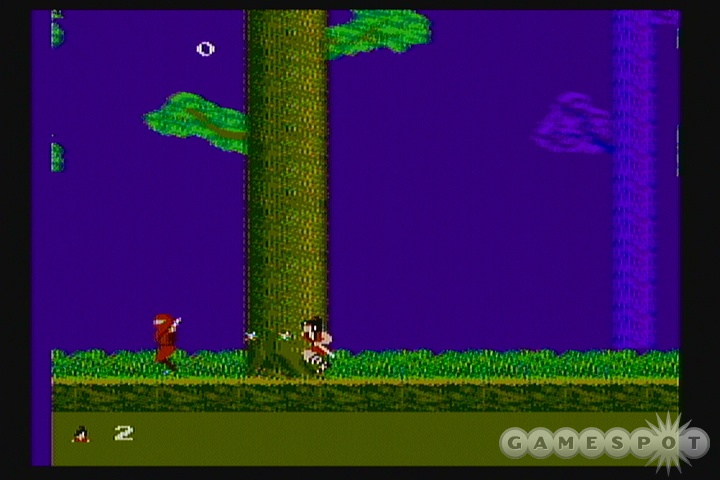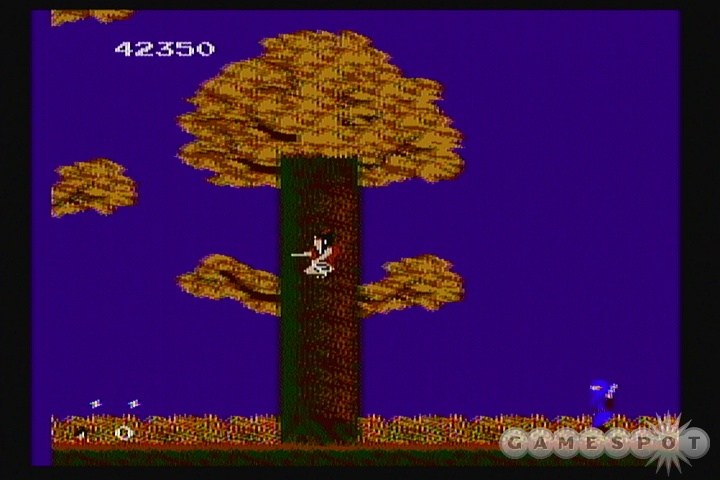Now that the Nintendo Entertainment System version of The Legend of Kage is available for the Wii's Virtual Console, you can experience the same sinking feeling that players felt within minutes of powering up the cartridge 20 years ago. After you press the start button, a brief noninteractive scene introduces the story. Apparently, it's the Edo period in Japan, a princess has been kidnapped by a warlord, and you've been hired to rescue her. So, with your trusty sword and an endless supply of throwing knives, you set out to fight your way through multiple levels of a dojo that's populated by other ninjas bent on killing you. Once the cinematic is over, you're thrown right into the game. It's all downhill from that point.

In simple terms, The Legend of Kage is like every other side-scrolling action game. You're supposed to run to the end of the level, use your jump to scale platforms and avoid attacks, and use your weapons to kill the bad guys that constantly appear. However, accomplishing those tasks isn't simple at all, because every action in the game has some frustrating consequence inherent to it. You can jump to ridiculous heights, but you're open to attacks until you land. You can stab enemies and block attacks with your sword, but your sword has a range of about four pixels and stays drawn for just an instant. So, you end up throwing knives most of the time. That works, except that you can only throw two of them at a time, and then you have to wait until they leave the screen before you can throw more. Even if you get the hang of these restrictions, success is more a matter of luck than skill. When new enemies appear, they tend to throw a knife or fireball immediately. If you happen to be standing in the line of fire or landing from a jump when an enemy appears, you're going to get hit and lose one of your three lives. That's what people will probably remember most about The Legend of Kage: cheap deaths that you have no control over.
Also, since the game was originally developed as a quarter-munching arcade cabinet way back in 1985, it reflects the limited capabilities and bite-size play sessions offered by arcade games from that early period. The faceless ninja characters look fine painted with four colors, but there are only two frames of movement for every action. The trees and decorative screens in the background are intricately detailed, but everything else is painted shades of blue, grey, or pink. The game's sound effects consist of beeps and ticks. Surprisingly, the short melodies that play during each stage have an Asian flavor about them and aren't altogether unpleasant, even though they're also made up of beeps and blips. The NES didn't have any trouble with the graphics and audio when Taito ported the game to it in 1987, and the Virtual Console has no trouble emulating the NES game now.

As far as overall length goes, there are only five different stages and six different enemies. Each stage takes less than a minute to get through. However, the catch is that you have to go through the game three times to truly beat it. Every time the game loops, the stages change color and enemies become more plentiful. In theory, it's possible to beat the game in 10 minutes. Of course, with luck being such a factor in whether you live or die, you'll probably make numerous attempts before you get through the whole thing in one sitting.
Some games are brief but beg to be played over and over again. The Legend of Kage isn't one of those games. Its design is repetitive, Kage's attacks are lame, and the constant cheap deaths are frustrating. Even at the low price of 500 Wii points ($5), the NES version of The Legend of Kage that's available on the Virtual Console isn't worth buying.